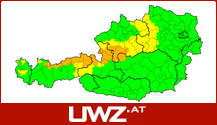Supercell (thunderstorm)
The king of the thunderstorms
A quick definition. A supercell is considered a supercell when it or its updraft rotate constantly for at least 15 minutes. This rotating updraft field (if it exists for over 15 minutes) is called a mesocyclone. A supercell can be a supercell if the criteria above are fulfilled – no other criteria have to be fulfilled for it to be a supercell.
It does not depend on:
The height (which can be between 5 and 20km)
The width (which can be a few up to 50km)
MILK Skywatch is still working on calculating averages for Germany, however some statistics for Austria are already available. About 7 to 10% of all thunderstorms in Austria turn into a supercell for at least part of their life. An even higher percentage has a mesocyclone for less than 15 minutes (and is therefore not considered to be a supercell!)
Threats from supercells
Storm gusts and downbursts (speeds significantly over 300km/h are possible)
Tornadoes (of all intensities)
Hail (which can reach sizes over 10cm and cover the ground about 1m high locally)
Extreme precipitation (flash flooding, landslides, large scale flooding)
High lightning rate (also at the dry edges of the supercell – forest fires)
General information
Supercells are individual thunderstorms that are incredibly well organized (in meteorological terms, of course – they don't really file all their papers). They can also occur embedded in MCSs (Mesoscale Convective Systems) or MCCs (Mesoscale Convective Clusters). But supercells can also occur in squall lines (preferably at the N or S end).
In the northern hemisphere, the mesocyclones generally rotate cyclonic (counter clockwise). The rotation is caused by wind shear. Wind shear is the change of wind speed (speed shear) and wind direction (direction shear) with the increase of altitude. Another significant feature of supercells is the big difference between the updraft and the downdraft regions. The updraft and downdraft regions are often hard to see by just looking at the thunderstorm, and often requires the analysis of time-lapse videos to find.
Types of supercells
Supercells are distinguished based on the intensity of their precipitation.
Low-precipitation supercells (LP-supercells)
The precipitation can only be observed in a small region, located (usually) in the center of the supercell. This does, however, not mean that the precipitation is weak – in fact, the precipitation is usually very intense in the cell core. Large hail can frequently be observed in the cell core of low-precipitation supercells. The hail often falls “dry”, meaning that there is no or only little accompanying rain. Tornadoes, however, are quite rare in low-precipitation supercells. LP-supercells frequently turn into classical supercells or high-precipitation supercells during their lifetime.
Classical supercells
The classical supercells are the most common type of supercells. They have a larger area of precipitation than the low-precipitation supercells and have a higher chance of tornadoes.
High-precipitation supercells (HP-supercells)
High-precipitation supercells have a large and intense field of precipitation, which often brings hail and extreme rain to vast areas. The strongest part of the precipitation is usually located around the mesocyclone, so that the mesocyclone cannot be seen. On the radar, there is then a kidney-shaped structure. The intense rain around the core of the thunderstorm wraps tornadoes as well, however, obscuring them from view.
What is the difference to normal thunderstorms?
Supercells generally exist longer than “normal” thunderstorms – this is due to the clear locations of updrafts and downdrafts, enabling a well-organized system to form. This difference in where the updraft and the downdrafts are located is caused by a strong speed shear, which pushes the precipitation and downdrafts away from the updraft. This enables the system to exist for a very long time. It is not rare for supercells to exist for 8 hours – many of them move through several countries during their lifetime.
Supercells tend to shear to the right (compared to the main wind direction of the mid-level winds). This can be clearly observed on the radar – supercells tend to take a bow-shaped path.
Supercells have very interesting cloud formations, most prominently the wallcloud. This is caused because of the condensation of the part of the rain-free updraft that borders the cloud. Also visible clearly and commonly is the flanking line, a line of cumulus clouds that extend in a band away from the supercell.
Sometimes you can see a tailcloud attached to the wallcloud. This extends from the wallcloud towards the downdraft, and shows that there is an intense interaction between the rising and the sinking air currents. Sometimes, horizontal rotation of the tailcloud can be seen. The tailcloud is also known as inflow tail.
Similar to the tailcloud, but not in direct relation to the wallcloud, is the beaver tail cloud. Both cloud types (tailcloud and beaver tail) usually signalize that the supercell thunderstorm is intense.
Another, clear sign of supercells are the unusually intense side-effects, like tennis ball sized hail or intense downdrafts (downbursts) About 10 to 20% of the supercells (in Austria) form (mesocyclonal) tornadoes, which sometimes are not documented because they get wrapped in rain.
If you have a great enough distance to the thunderstorm, you can sometimes see an overshooting top which pushes up above of the anvil. This shows that there are very intense updrafts within the supercell.
Attachment:
Current warnings




© M.I.L.K. 2017
M.I.L.K. - Meteorology: Information. Learning. Knowledge.


